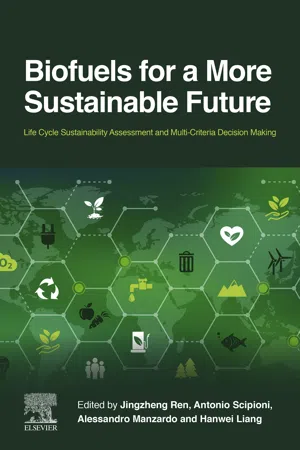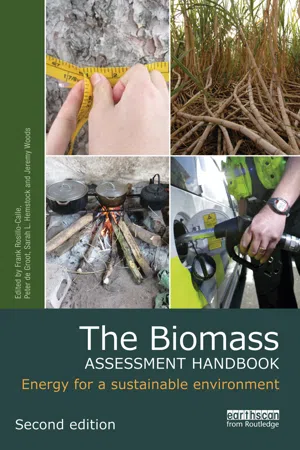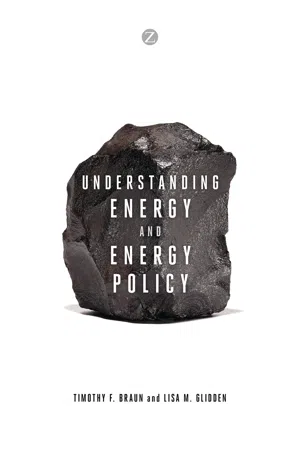Biofuel
Biofuel refers to renewable fuels derived from organic materials such as plants and animal waste. These fuels are used as an alternative to traditional fossil fuels and are considered more environmentally friendly. Common types of biofuels include ethanol, biodiesel, and biogas, which can be used to power vehicles and generate electricity.
6 Key excerpts on "Biofuel"
- eBook - ePub
Renewable Energy and Green Technology
Principles and Practices
- Narendra Kumar, Hukum Singh, Amit Kumar, Narendra Kumar, Hukum Singh, Amit Kumar(Authors)
- 2021(Publication Date)
- CRC Press(Publisher)
...According to the report of the World Resources Institute, the quantity and demand of fuel consumed globally is expected to grow rapidly. It also warned that the use of fossil energy causes significant problems and harmful effects on the environment. Renewable energy sources are critical to solving the world’s energy crisis. Biofuels are an excellent example of renewable energy produced by biological organisms that reduce the country’s dependence on fossil fuels. Photosynthesis is capable of increasing the amount of plant and algal biomass by using large-scale atmospheric carbon dioxide. Therefore, Biofuels and biomass-derived fuels are based on photosynthesis and may be the key to achieving energy requirements that are eco-friendly and cost-effective. Much work has been done to improve the efficiency and effectiveness of Biofuel production processes from biomass algae. The Biofuel of the third generation must be free from the drawbacks of the first two generations. Many works aim to optimize the algae cultivation system: the open-air system and the photo bioreactor. Since Indian crude oil production is almost stagnating to overcome the country’s fuel demand, although various indigenous technologies for bioethanol and biodiesel production from different bio-based feedstocks have been developed, due to the unavailability of sufficient feedstocks, these bio-fuels’ industrial production is still in its infancy. The central government, along with state governments, need to take more and more effective initiatives to ensure adequate availability of feedstock to the Biofuel industry. References Agriculture Organization. 2008. The State of Food and Agriculture 2008: Biofuels: Prospects, risks and opportunities. Food and Agriculture Organizer 38. Ajanovic, A. 2011. Biofuels versus food production: Does Biofuels production increase food prices? Energy 36(4):2070–2076. Amin, S. 2009...
- eBook - ePub
Biofuels for a More Sustainable Future
Life Cycle Sustainability Assessment and Multi-Criteria Decision Making
- Jingzheng Ren, Antonio Scipioni, Alessandro Manzardo, Hanwei Liang(Authors)
- 2019(Publication Date)
- Elsevier(Publisher)
...Biofuels can be divided and separated into several groups based on their technologies, processes, and feedstocks. Biofuels technology can be defined as application of feedstocks in a sequence of processes leading to the production of different Biofuels types. Biofuels processes are either natural or chemical stages of an industrial or pilot project development leading to the final production of Biofuels. Biofuels feedstocks are any living, dead, or decomposed plant materials suitable for processing and conversion to Biofuels by means of different processes. From the perspective of the industrial development and market presence, Biofuels feedstocks, processes, and technologies can be classified as “developed” (with well-established markets), “developing” (with newly created or progressing market shares), or in the “demonstration” stage (describing pilot projects or potential future developments) (compare: Lane, 2017). Due to a high feedstock variability accessible to be utilized for Biofuels generation the existing Biofuels technologies and processes have expanded over time thus creating a wide net of production opportunities and innovation potential in this field. Generally, Biofuels technologies can be divided into “conventional” and “advanced” Biofuels (Fig. 1.1). Conventional Biofuels (also called “first generation Biofuels”) designate ethanol and biodiesel generated from eatable crops. Advanced Biofuels (encompassing the “second, third and fourth generation Biofuels”) are defined as liquid fuels from nonfood/nonfeed sustainably grown feedstocks and agricultural (municipal) wastes. The need for advanced Biofuels originated from a concern about the competition for natural resources (e.g., water, energy, land) between fuel and food production (Rathmann et al., 2010 ; Harvey and Pilgrim, 2011, Ajanovic, 2011)...
- eBook - ePub
Biodiesel Science and Technology
From Soil to Oil
- Jan C.J. Bart, N Palmeri, Stefano Cavallaro(Authors)
- 2010(Publication Date)
- Woodhead Publishing(Publisher)
...In any case, water, oxygen and CO 2 enable life. In a higher CO 2 environment crop growth rates may be expected to increase to the benefit of agriculture. The search for alternatives to fossil fuels dates back to the petrol crisis of the early 1970s, but just more recently the looming dangers of a global climate change are driving renewed interest in Biofuels. The world is awakening to the renewable fuels movement and the public clamours for alternatives to foreign petroleum. The last 25 years have witnessed a gradual but growing shift towards greater use of plant matter as a feedstock for both energy and chemical products. The combination of steeply increasing oil prices (in particular in the past few years), environmental awareness, relatively low cost of plant material (until recently), and the development of biorefineries prepare mankind for a historic transition into a sustainable society in which biological feedstocks, processes and products become the main pillars of the economy. This calls for further developing the necessary science and technology that enable this transition, while at the same time investing in infrastructure and defining economic and policy issues. The various biomass-based resources used so far for fuel generation have mostly been (expensive) food crops, but biomass also consists of (cheap) agricultural and forest residues (e.g. crop residues, rice husk, cotton stalk, pine sawdust, sugarcane, bagasse, etc.), urban and industrial residues. Renewable and sustainable resources, which can be used as an extender or a complete substitute of diesel fuel may play a significant role in agriculture, industrial and transport sectors in the energy crisis situation. Agricultural and transport sectors are highly diesel dependent. Various alternative fuel options for diesel are mainly biogas, producer gas, ethanol, methanol and vegetable oils. Development of new energy sources replacing fossil sources is the greatest challenge of the 21st century...
- eBook - ePub
The Biomass Assessment Handbook
Energy for a sustainable environment
- Frank Rosillo-Calle, Peter de Groot, Sarah L. Hemstock, Jeremy Woods, Frank Rosillo-Calle, Peter de Groot, Sarah L. Hemstock, Jeremy Woods(Authors)
- 2015(Publication Date)
- Routledge(Publisher)
...With modern energy-conversion technologies it is possible to displace fossil fuels with an equivalent Biofuel. When biomass is grown sustainably for energy there is no net build-up of CO 2, assuming that the amount grown is equal to that burned, as the CO 2 released in combustion is compensated for by that absorbed by the growing energy crop, although this notion is being constantly questioned. The sustainable production of biomass is therefore an important practical approach to environmental protection and longer-term issues such as reforestation and re-vegetation of degraded lands and in mitigating global warming. Indeed, a combination of environmental considerations, social factors, the need to find new alternative sources of energy, political necessities and rapidly evolving technologies are opening up new opportunities for meeting the energy needs from bioenergy in an increasingly environmentally conscious world. Continuing difficulties with data/classification of bioenergy Information on the production and use of bioenergy is plagued with difficulties due to a lack of reliable long-term data. Even when it is available this data is often inaccurate and too site-specific. Biomass energy, particularly in its traditional forms, is difficult to quantify because there are no agreed standard units for measuring and quantifying various forms of biomass, making it difficult to compare data between sites. Furthermore, as traditional uses of biomass are an integral part of the informal economy, in most cases it never enters official statistics. Given the nature of the biomass resource, developing and maintaining a large bioenergy databank is very costly. Biomass is generally regarded as a low-status fuel, as the ‘poor person’s fuel’. Traditional bioenergies, e.g...
- eBook - ePub
- Timothy Braun, Lisa Glidden(Authors)
- 2014(Publication Date)
- Zed Books(Publisher)
...4 | BIOMASS AND BiofuelS Biomass Biomass refers to the use of plant material as a fuel source. Wood, straw, dried animal dung, and charcoal are examples of biomass fuels than have been used by humans for thousands of years. Often biomass is burned to release some of the stored solar energy originally captured by plants. Biomass represents humans’ earliest use of stored energy, so it should not be surprising that it is still a primary energy source for cooking and heating for roughly a third of the world’s population, mainly in the global South. Burning biomass indoors with inadequate ventilation is a significant health hazard. Inhalation of smoke and other fumes from burning biomass leads to lung problems and infections for large numbers of women and young children in these areas (WHO 2010). Advanced technologies just coming on the scene may be able to convert biomass into a range of liquid and gaseous fuel stocks. Ethanol, a two-carbon alcohol, is a primary Biofuel at present. The world’s largest ethanol producers are the USA, Brazil, the EU, and China, with the USA producing eleven times more than the EU and Brazil producing five times more than the EU in 2012 (Renewable Fuels Association 2014). The world’s largest biodiesel producers in 2011 were the European Union, the USA, Brazil, and Argentina, with the EU producing about three times more than the other leaders (IEA-ETSAP and IRENA 2013 : 1). The advantage of Biofuels lies in their sustainability, minimal contribution to global warming, and local production. In theory if you are harvesting plant matter to burn, the CO 2 released is taken up by new plants to again store the carbon as plant material. Unfortunately it is often not quite that simple. To be truly sustainable the Biofuel must yield more energy than was put into making it, its EROeI must be at least greater than 1 and realistically greater than 3...
- eBook - ePub
- Volker Quaschning(Author)
- 2016(Publication Date)
- Routledge(Publisher)
...If the share of ethanol is greater, however, the engines have to be modified. Since the 1970s, bioalcohols from sugarcane have been used on a large scale as vehicle fuels to substitute expensive fossil fuels in Brazil. Today, bioalcohol is available in practically every filling station in Brazil. ‘Flexible fuel vehicles’ are also widespread in the country. Such cars can run on a wide range of fuel blends with the share of ethanol ranging from 0 to 85%. In the past few years, a number of systems for the production of bioethanol from rye, corn, and sugar beets have also been built in Germany. Recently, food prices have skyrocketed, worsening the affordability of bioethanol production considerably. Morally, bioethanol is also controversial because it competes with food crops. Biomass-to-Liquid (BtL) fuels When vegetable oil, biodiesel, or bioethanol is used, the only plant parts that can be used to produce fuel are those containing oil, sugar, or starch. The second generation of Biofuels is to tap a wider range of resources. BtL (Biomass-to-Liquid) is the name for the synthetic production of Biofuels. A wide range of raw materials can be used completely for this purpose, such as straw, biowaste, forest waste, and special energy crops. As a result, the potential of Biofuels increases tremendously, as does the amount of land that could be used. It is relatively complex, however, to produce BtL fuels. In the first stage, the biomass raw material is gasified. Oxygen and water vapour are added at high temperatures to produce a synthetic gas consisting of carbon monoxide (CO) and hydrogen (H 2). Across various gas purification stages, the carbon dioxide (CO 2) is separated from other undesirable elements, such as sulphur and nitrogen compounds...





